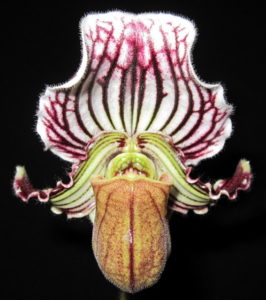Paphiopedilum fairrieanum…everyone loves it but not everyone can grow it. That’s a shame because it is truly one of the most unique flowers in the slipper orchid world. It also can be very easy to grow and bloom as long as you understand its requirements.
In order to learn about its requirements, we need to look at its natural habitat. Paphiopedilum fairrieanum comes from relatively high elevation in Eastern India and Bhutan. This area is subject to seasonal monsoons. The wet season is very wet with heavy rains. The plants grow on limestone cliffs or in trees along rivers. When the dry monsoon prevails the region still receives light rains and heavy dews as the temperatures drop every night.
What can we conclude from this? Growing as an epiphyte or lithophyte (on trees or rocks) means that water drains away quickly and the roots do not remain soggy even in the wet season. The heavy dews of the cooler months will keep the plants from getting dry. This is a plant that never dries out completely in situ. Our experience in culture is that this species has smaller root systems than many other Paphs. This makes sense…if their substrate is always damp, they don’t have to look too far for water. It has also been our experience that if the plants dry out completely, they die.
Paphiopedilum fairrieanum in culture

How do we replicate these conditions? We use a well-drained mix with Orchiata seedling bark and about 30% number 3 perlite. In the hottest summer months, we water up to 3 or 4 times per week. This may not be necessary if you are in a more moderate climate with good humidity. We are in Northern California where summer days are regularly 100 F. Our coolers can keep the greenhouse in the low 80’s but such massive air movement dries things down pretty fast. In the cooler winter months we reduce watering to twice per week.
Speaking of temperature, we mentioned that these come from higher elevation. They are considered cool to intermediate growers. We have had good success as long as we keep summer highs in the mid to upper 80’s F. Winters can be quite cool in their natural habitat. Night temperatures can fall into the low 40’s F. We keep them in the mid 50’s on our coldest nights. Remember not to let the plants sit in very wet media if your nights are very cold.
More about water
Back to watering. When we water Paphiopedilum fairrieanum we pay particular attention to them. Flushing plants very thoroughly with water is very Important for all orchids, but we go ‘extreme’ here. We water the pots from all sides, multiple times. Since they receive heavy rainfall they do not have much mineral build up around them. Flushing the plants over and over helps prevent salt build up and gets plenty of air to the roots.
We keep these plants on the damp side so the potting mix can break down quickly. These should be repotted every year into fresh bark. Keep them in relatively tight pots and move them to larger pots only when you can’t get the roots back into the smaller one.
Keeping your Paph fairrieanum happy
So, you have been following these tips you are well on your way to growing a robust specimen plant. Maybe you started in a 2” pot and have moved through a 3.5” pot and have a multi-growth plant in a 5” pot with 5 or 6 flowers. Now your friend wants a division so you break off a piece the next time you repot it. Congratulations…. you just killed your plant! Never divide this species. NEVER! This will almost always result in its demise. If you have been patient enough to grow this big specimen plant, you can wait a couple more years. Usually larger plants will fall apart on their own, producing smaller divisions when they do.
This may make it sound like Paphiopedilum fairrieanum has excessive requirements. It really doesn’t. You just need to remember that it can never dry out completely, but should not stand in water either. Water thoroughly, repot annually and never force a division. Seems pretty simple, especially for such a rewarding and beautiful species.
We have been breeding this species for many years and have some of the finest Paphiopedilum fairrieanum in the world. You can purchase our award winning plants: Paphiopedilum fairrieanum
